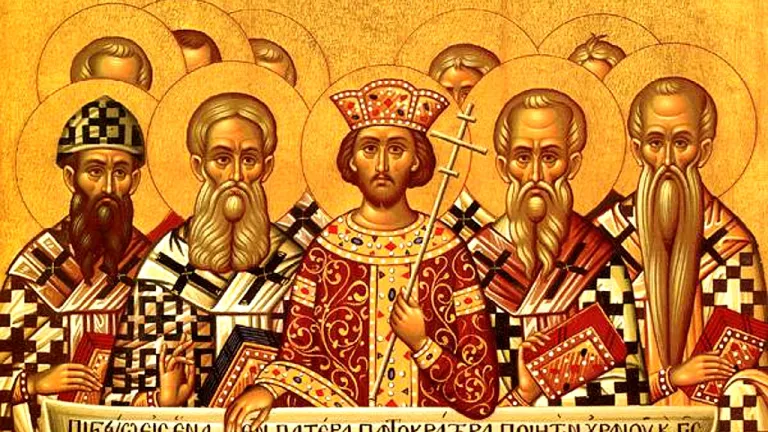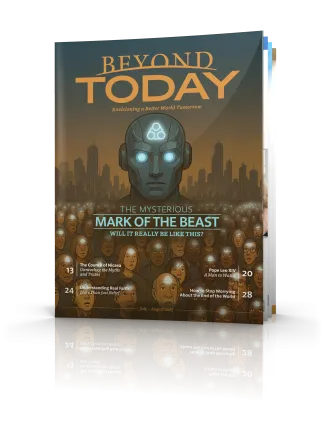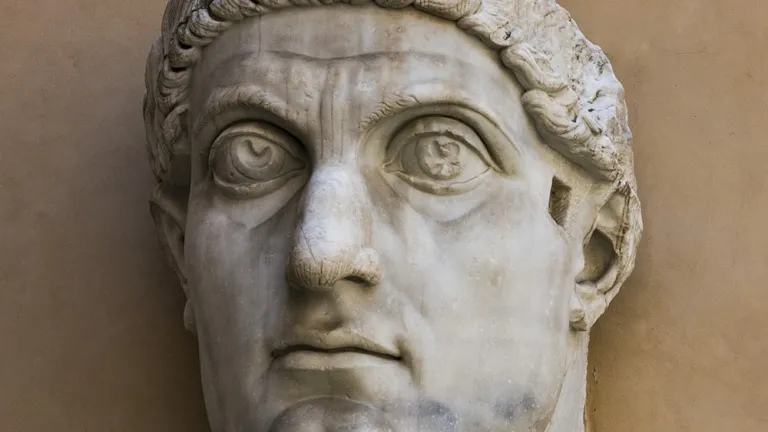The Council of Nicaea: Unraveling the Myths and Truths

This summer marks the 1,700th anniversary of the Nicene Council, which helped to define mainstream Christianity. What emerged from the fourth century was a church of unbiblical teachings with controlling sway over society, including everyday people and their rulers. It was a different church from that founded by Christ through His apostles.
Following up on ecumenical efforts under the late Pope Francis to help heal the thousand-year-old rift between Roman Catholicism and Greek Orthodoxy, the new pope Leo XIV met with the Orthodox patriarch Bartholomew in Rome, and they agreed to meet later this year at the site of ancient Nicaea in western Turkey to jointly observe the 1,700th anniversary of the famous church council there, a major part of their common tradition (see related article in this issue).
For the Christian world, the Council of Nicaea, held from May through August of A.D. 325, is seen as a pivotal moment in the history of the church. Convened by Roman Emperor Constantine the Great, it began the formulation of the Nicene Creed, the establishment of Trinitarian doctrine and the supposed unification of Christianity. For professing Christendom, the Nicene Creed, along with its expansion at Constantinople to follow, is the litmus test for being considered a Christian. Deny this creed and you are labeled anathema from Christ.
Ironically, most do not understand the full historical and biblical implications of what truly took place at this influential gathering. Indeed, most who profess to be Christian could not repeat the adopted creed nor explain the key theological tenets covered. Its historic importance cannot be denied. Arguments over the rules of faith espoused in the creed and its later enhancement resulted in more deaths than Rome ever martyred in the Colosseum.
Many believe that the Council of Nicaea was a divinely inspired meeting that solidified the correct understanding of God, Jesus Christ, and Christian doctrine and practice. Others argue that it marked the beginning of a shift away from biblical teachings toward human traditions and theological speculation. What was the true purpose of the council? What role did Emperor Constantine play? And most importantly, does this event and the subsequent teaching align with biblical truth?
On this significant anniversary, let’s consider the historical context, theological debates and long-term impact of the Council of Nicaea and compare its conclusions with what the Bible actually teaches.
The historical context of Nicaea
To understand the Council of Nicaea, we must first look at the Roman world of the fourth century A.D. Prior to Emperor Constantine’s rise to power, Christianity had been a persecuted minority religion. Roman emperors such as Nero, Domitian and Diocletian suppressed Christian beliefs through violent means. While the Christian church at the turn of the fourth century differed from the Church founded by Christ and His apostles, it was a growing force within the empire. It had a unity that made it attractive to Constantine. His empire was showing fault lines.
In 313, Constantine issued the Edict of Milan, granting Christians the right to worship freely. As the first Roman emperor to embrace Christianity—although arguably for political reasons rather than personal conviction—Constantine sought to unite his empire under one religious system. The Christian church had a system of bishops and structure that could aid in that.
There was, however, a growing problem that if left unresolved threatened to split the church. There was significant dispute over the nature of Jesus Christ. Was He fully divine and eternal, or was He a created being? This dispute led to one of the most significant theological conflicts in early Christianity—the Arian controversy.
The Arian controversy and the purpose of Nicaea
The Council of Nicaea was convened primarily to settle the dispute concerning the teaching of Arius, a presbyter or elder from Alexandria in Egypt who argued that Jesus Christ was not divine in the same way as God the Father. According to Arius:
1. Jesus was not coeternal with the Father but was created at some point.
2. Jesus was greater than human beings but lesser than God the Father.
3. The Father alone was the true Almighty God.
This heretical teaching denied the fundamental truth of the Bible regarding the divine nature. God is a family composed of two coeternal spirit beings who together initiated a plan to expand Their family through the creation of mankind in Their image (Genesis 1:27). This truth was understood by the apostles and formed the foundation of the gospel they took to the world.
The apostle Paul explained that this nature of the divine family was the means by which all things in heaven and earth would be brought together as one (Ephesians 1:9-10).
The teaching that Christ was not divine before His human birth would render null the good news of humanity’s salvation through Christ, the One through whom God created everything (see Colossians 1:16-17). Denying this truth discounts the Bible, hollowing it out as only a book of men instead of the revelation of a divine mind that has given it life and meaning.
This fourth-century argument over the nature of Christ set the stage for discussions that would lead the church further into heresy. The debate was heated and divisive, prompting Constantine to intervene and call for a council to resolve the issue. He needed the church to be united. In his mind the future of the empire depended on the stability of the church.
What happened at the council?
The Council of Nicaea was attended by around 300 bishops from various parts of the Roman Empire. It was not the first gathering of church leaders in this era, but it’s considered the first of importance, given the issues under discussion.
In addition to the divinity of Christ, the Council discussed other matters about the relationship of Christ and the Father. It tried, but failed to establish a uniform date for Easter, which had supplanted the Passover and Days of Unleavened Bread, which the early Church faithfully observed. Constantine’s invective against the Jews and banning of Christians from following perceived Jewish practice inflamed antisemitism and persecution against those who persisted in the earlier observance.
Ultimately, the council rejected Arius’ teachings and formulated what is now known as the Nicene Creed, which stated:
1. Jesus Christ is “God from God, Light from Light, true God from true God.”
2. He was “begotten, not made, of one substance [Greek homoousios], with the Father” (wording understood by many to mean these divine persons constitute a single being).
3. Those who did not accept this doctrine were to be anathematized (cut off or excommunicated).
This version of the creed ended with a brief stated belief in the Holy Spirit but did not directly identify the Holy Spirit as a third person of the Trinity, that issue awaiting further development. Nicaea’s work was not finished. Arius would be exiled and die without recanting his ideas. Scholars would debate the teaching and eventually devise terminology to explain the nature of God.
Arianism was so pervasive and divisive as to find co-emperors of the empire each holding divergent views. In 376, at the Battle of Adrianople in northwestern Turkey, the co-emperor Valens, who was Arian by belief, was killed along with his legion of soldiers by invading Germanic tribes. The death of an Arian emperor shook the faith of many and is thought to be a factor leading to the calling of another council, this time in Constantinople and presided over by the emperor Theodosius.
This famous council of A.D. 381 formalized the teaching, in what is called the Niceno-Constantinopolitan Creed, that not only is Christ God, but so is the Holy Spirit. It states belief in the Holy Spirit as “the Lord, the Giver of Life, who proceeds from the Father, who with the Father and the Son is adored [or worshiped] and glorified.”
Yet it is crucial to recognize that the developing doctrine of the Trinity was not based on direct biblical statements. Greek philosophical ideas and theological interpretation were the basis of the teachings emanating from these two critical councils of the fourth century. It was not God’s Spirit that was guiding these meetings laying the heretical theological foundation for the Trinity doctrine, the central tenet of Christendom.
The Nicene Creed, as further formulated at Constantinople, unifies post-Nicene Christianity. When read and confessed in churches by traditionalist believers, it is a unifier where much theological division exists. To not accept the creed and its teaching of a triune God is to be branded a heretic and even a non-Christian.
What the Bible actually teaches
Does the Bible support the Trinity as defined at Nicaea and Constantinople? The answer is no. Nowhere does the Bible teach that God is a trinity of three coequal divine persons existing as a singular triune being. The Bible reveals that before there was anything, there were two Beings who were God—identified as God the Father and the Word who was with God and was also God, the One who became flesh and dwelt among men (John 1:1-3; John 1:14).
In putting all the various passages together, we discover that there is one God comprising two distinct divine Beings. These two, the Father and the Son, are two self-conscious individuals, each with free will, though unified as one in spirit and purpose (John 10:30). The one God is the divine family. (To better understand, be sure to read our free study guide Is God a Trinity?)
The Holy Spirit is God’s power and projected presence, not a separate person. As Mary was told of the conception of Jesus, “The Holy Spirit will come upon you, and the power of the Highest will overshadow you” (Luke 1:35). Upon repentance, a complete change of life, one can be baptized and receive the gift of the Holy Spirit as the indwelling life essence of God (Acts 2:38).
Clearly, the biblical description of God differs significantly from the philosophical doctrine formulated in the fourth-century councils.
The long-term impact of Nicaea and the Trinity doctrine
The Council of Nicaea, and to an even greater degree the Council of Constantinople, set in motion events leading to the rise of the great “Christian” church of history. A church with a recognized hierarchy with the pope at the top. A church recognized by the Roman Empire, both in the West and the East, and whose teaching could be enforced by the power of the state.
Those continuing to teach and practice according to the Bible as taught by the early apostolic church were summarily pushed aside, becoming viewed as fringe and dangerous to Christian harmony. The observance of the biblical feasts was essentially banned.
In A.D. 380, Theodosius issued an edict declaring the new Nicene orthodoxy as supreme in the eastern church. The state was declaring spiritual law. Theodosius decreed that true Christians were those who believed in “the single divinity of the Father, Son and Holy Spirit within an equal majesty and an orthodox Trinity.” For all intents this remains the accepted standard. In the eyes of today’s Christian world, you are not “Christian” if you do not believe in the statement of the Trinity formulated at Nicaea and Constantinople.
Here’s what this meant in the fourth century: As a bishop, to hold a variant view would cause you to lose your role in the church. As a member, you could not enter the church and worship God. The door of the church was barred to you. You could not receive the sacraments of baptism, communion or funeral rites. You were “anathema from Christ.” Substantial blocs of Christians were denied access and association with the church.
After the 381 Council of Constantinople, a decree from the emperor, with the assent of the bishops, declared: “We now order that all churches are to be handed over to the bishops who profess Father, Son and Holy Spirit of a single majesty, of the same glory, of one splendor, who establish no difference by sacrilegious separation, but [who affirm] the order of the Trinity by recognizing the Persons and uniting the Godhead.”
To believe or even be in possession of writings teaching contrary to this could be punishable by death. While difficult for our modern minds to grasp, that is what happened then and later—and will happen again. Your Bible shows a time is coming when to hold views contrary to what’s taught by a tyrannical church-state union will again result in people having to make a choice between obeying the truth of God or that of the false power. Choices made at that time are matters of spiritual life and death. It is serious! Which leads to why this is important.
The great Christian church that rose from this period came to dominate the lives of adherents. Salvation itself was tied to obedience to teaching and participation in the rituals of what was declared the true faith. With question of Christ’s divinity resolved, the focus was now on how could fallen man be redeemed. How could one’s “immortal soul” be guaranteed entrance into heaven, avoiding the ravaging fires of eternal damnation? This became very real. The church was perceived as the “City of God” on earth. The ecclesiastical hierarchy held power to absolve one of sin. Access to the communion, the body of Christ, was through the priest and the church.
People began to worship and pray to dead saints in heaven. In time the cult of worshiping the virgin Mary as Mother of God came to its critical role in theology. What emerged from the fourth century councils and debates was the foundation of a church whose teachings founded in tradition and not the Bible held controlling sway over the lives of everyday people and those who dwelt in the castles and palaces of power. It was a different church from that founded by Christ through His apostles.
Why this matters for Christians today
Understanding the Council of Nicaea of 1,700 years ago is critical for those who seek to base their faith on Scripture rather than human traditions. Many mainstream Christian beliefs today stem from church councils rather than clear biblical teachings. As believers, we must examine what the Bible actually teaches rather than accepting historical creeds. Be aware of how doctrine developed and how political forces shaped Christianity. Seek a personal relationship with God based on His revealed truth, not inherited theological traditions.
The Council of Nicaea was a defining moment in Christian history, but it was not a moment of biblical revelation. Rather, it was a political and theological event that shaped mainstream Christianity. While it established doctrines that many follow today, it is essential to compare these teachings with the Bible itself. Each of us must test all things and hold fast what is good (1 Thessalonians 5:21).
As truth-seekers, let us be diligent in studying God’s Word and ensure that our beliefs align with Scripture, not false tradition!







